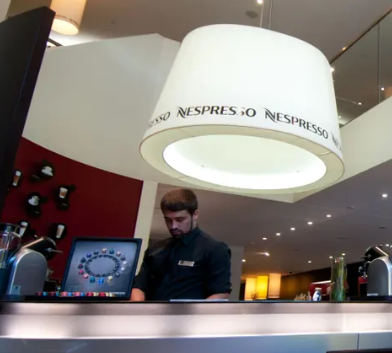After Gaillard’s reforms, Nespresso finally took off, but it is Favre who tends to take the plaudits as the creator.
在蓋拉德實施改革后,奈斯派索咖啡機最終成功了,但是獲得了最多的贊譽的是它的發(fā)明者法夫爾。
The story of the tinkerer playing with pipes and valves in his workshop is more appealing than the smooth corporate rebranding exercise.
一個在自己的車間里擺弄管子和閥門的工匠的故事,要比企業(yè)順利地進行品牌重塑更有吸引力。
Gaillard is only too glad to correct the record. “Those who really know the story, know it was me,” he said.
蓋拉德非常想糾正這一事實。他說,“那些真正了解這個故事的人,知道我才是那個人。”
“Favre was a technician. He couldn’t run the business.”
“法夫爾是一個技術(shù)人員。他不會做生意。”
In 1990, after two years of struggle and personality clashes between the two men, Favre resigned, the result of what he described as a “coup d’etat”.
1990年,在兩人經(jīng)歷了兩年的斗爭和個性沖突后,法夫爾辭職了。他將這個結(jié)果形容為“政變”。
It doesn’t take much to reopen the old wounds. “Gaillard is un diable,” Favre told me.
揭開舊傷口不需要很多時間。法夫爾告訴我,“蓋拉德是一個魔鬼。”
In his version of the story, Gaillard was a brash operator who made his position unbearable.
按照他的講述,蓋拉德是一個自以為是的經(jīng)營者,這讓他的工作難以承受。
In 1997, Gaillard left Nespresso to run Nestle’s ice-cream business in the US.
1997年,蓋拉德離開了奈斯派索,轉(zhuǎn)而去美國經(jīng)營雀巢的冰淇淋業(yè)務(wù)。
He subsequently left the company after falling out with the then CEO, Peter Brabeck-Letmathe.
后來,他和公司當時的CEO皮特·包必達·萊特馬特爭吵后離開了公司。
The animosity between Gaillard and Nestle lingers.
蓋拉德和雀巢之間的敵意一直揮之不去。
“My name is forbidden at Nestle,” Gaillard said, noting that there is no mention of him anywhere on the company website.
我的名字在雀巢公司是被禁止的,”蓋拉德說,并指出公司網(wǎng)站上沒有任何地方提到他。
He described the Favre-centric Nespresso origin story as, at best, a simplification, which omits the work of the many other designers involved.
他說,以法夫爾為中心的奈斯派索咖啡機的起源故事充其量只是一種簡化,它忽略了許多其他設(shè)計師的作品。
He also claimed that the original idea for Nespresso came not from within Nestle but from a research organisation,
他還聲稱奈斯派索咖啡機的創(chuàng)意并非來自雀巢公司內(nèi)部,而是來自一個名為巴特爾研究所的研究機構(gòu)。
the Battelle Institute, which Gaillard said sold the idea to Nestle in 1973.
蓋拉德表示,該機構(gòu)于1973年將這個點子賣給了雀巢。
(Nespresso denied the claims. When asked to clarify Favre and Gaillard’s involvement, it replied with a generic history that mentioned no individuals.)
(雀巢否認了這一說法。)當被要求澄清法夫爾和蓋拉德與此事有關(guān)時,雀巢給出了一份籠統(tǒng)的歷史回答,沒有提到任何個人。)
One crucial factor behind Nespresso’s rise, unmentioned by Gaillard, was timing.
蓋拉德沒提到的一個奈斯派索攀升背后的關(guān)鍵因素是時機。
In 1998, Starbucks arrived in the UK, and elsewhere in Europe from 2001.
1998年,星巴克將店開到了英國,而且自2001年以來又將店開到了歐洲各地。
(Although not in Italy, which somehow held out until 2018.)
(但是它沒有在意大利開店,這個情況一直持續(xù)到2018年。)

Previously it had been difficult to get a decent coffee anywhere outside Italy.
在此之前,在意大利以外的任何地方都很難買到一杯像樣的咖啡。
At Starbucks, you could enjoy Italian-style coffee, which is to say freshly made and with frothy milk, marketed with Italian-style language.
在星巴克,你可以享受到意大利風(fēng)格的咖啡,也就是說,新鮮制作,帶有泡沫的牛奶,以意大利風(fēng)格的語言銷售的咖啡。
According to the historian of consumption, Jonathan Morris, Nespresso capitalised on these new tastes:
根據(jù)消費歷史學(xué)家喬納森·莫里斯的說法,奈斯派索充分利用了這些新口味:
“When customers started to ask how they could have Starbucks-style coffee at home,
“當顧客開始問他們怎么能在家里喝星巴克式的咖啡時,
Nespresso was the best-placed product to take advantage of that.” Between its Fortissio and Vivalto pods, it had the cod-Italian ready to go, too.
奈斯派索是利用這一需求的最佳產(chǎn)品。在它的弗啼西歐和維瓦托咖啡莢之間,鱈魚意大利菜也準備好了。


